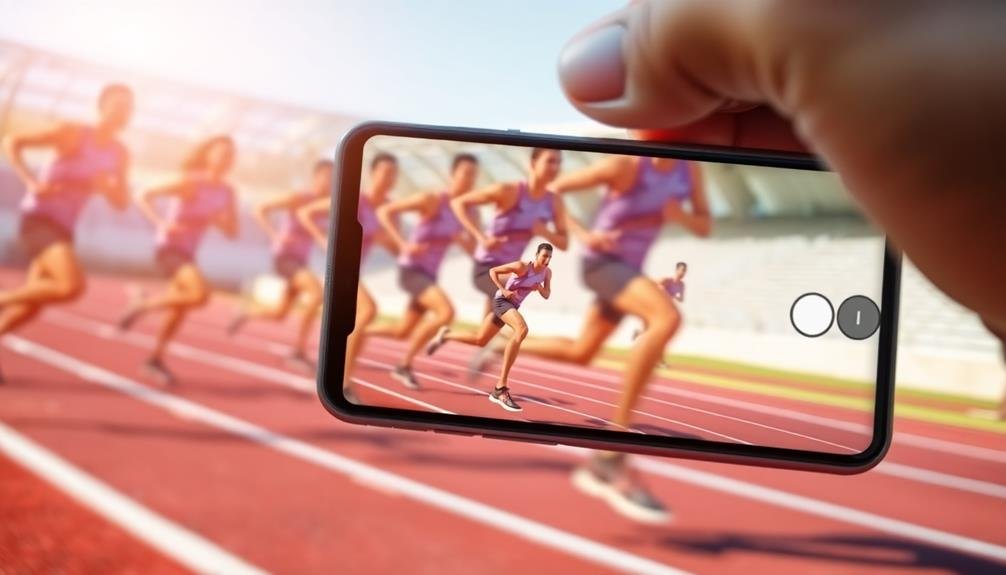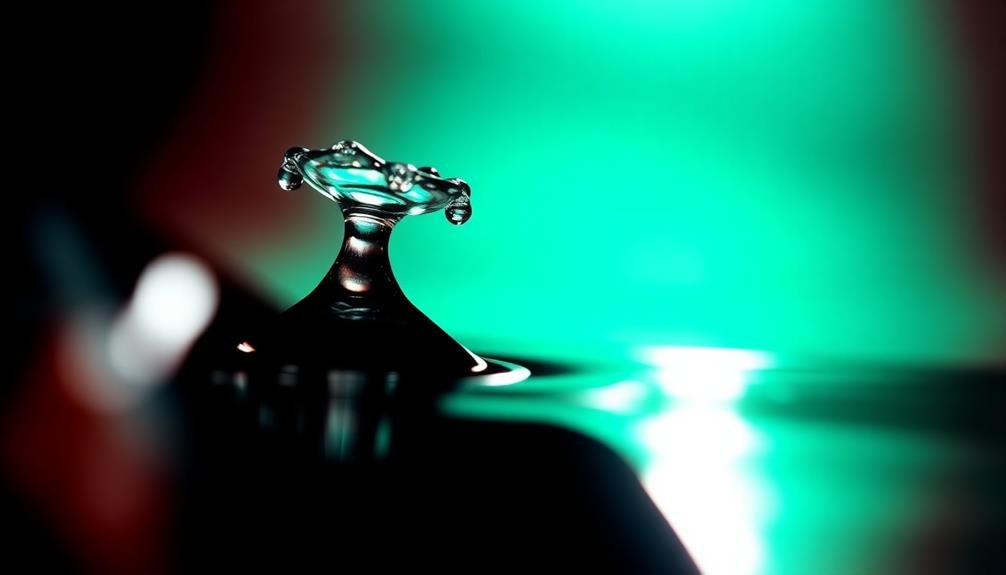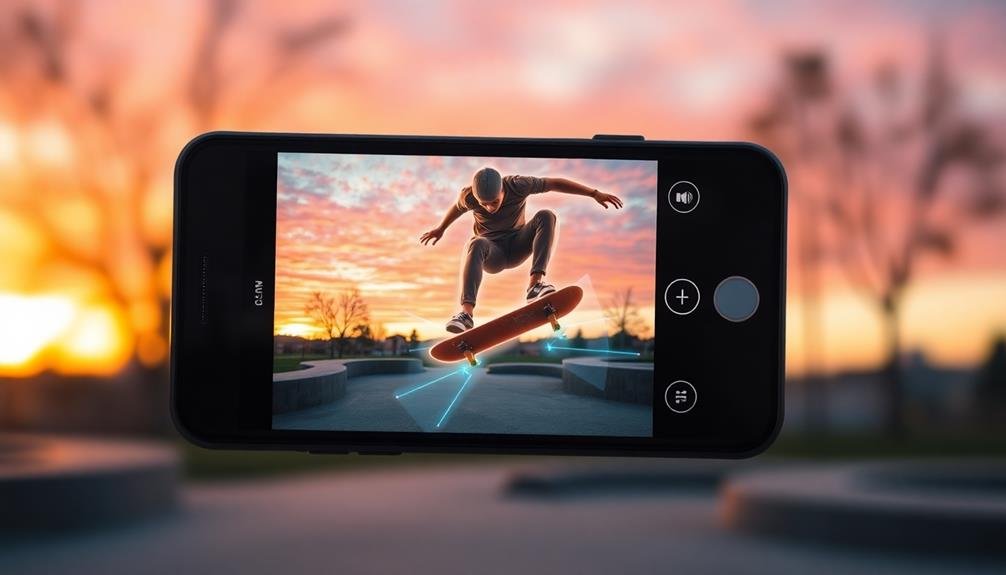Modern smartphones offer powerful features to help you capture stunning dynamic action shots. Burst mode lets you take multiple photos per second, increasing your chances of getting the perfect shot. Motion tracking autofocus keeps moving subjects sharp, while high-speed shutter settings freeze fast action. Optical image stabilization reduces camera shake, especially useful for zoomed shots. AI-enhanced action recognition optimizes settings automatically for dynamic scenes. These features work together to help you capture clear, exciting images of fast-paced activities. By understanding and utilizing these tools, you'll be well-equipped to take your action photography to the next level.
Burst Mode for Rapid Captures

Burst mode is a game-changer for smartphone photographers. It allows you to capture a rapid sequence of photos by simply holding down the shutter button. This feature is particularly useful when you're trying to capture fast-moving subjects or unpredictable moments.
When you activate burst mode, your phone's camera takes multiple shots per second, often up to 10 or more. This increases your chances of getting the perfect shot, especially in high-action scenarios like sports events or wildlife photography. You'll no longer miss vital moments due to slow shutter speeds or delayed reactions.
After taking a burst of photos, you can review the sequence and select the best shots. Most smartphones offer tools to help you choose the sharpest or most well-composed images from the burst. You can then save these individually or create animated GIFs from the sequence.
To use burst mode effectively, make sure you have enough storage space on your device and a steady hand. It's also important to take into account lighting conditions, as rapid shooting can sometimes lead to underexposed images in low light.
Practice with different subjects to master this powerful feature and elevate your mobile photography skills.
Motion Tracking Autofocus
In addition to burst mode, motion tracking autofocus is another powerful feature that's revolutionizing mobile photography. This technology allows your camera to lock onto a moving subject and keep it in focus as it moves across the frame. It's particularly useful for capturing sharp images of fast-moving objects or people, making it ideal for sports, wildlife, and action photography.
When you activate motion tracking autofocus, your phone's camera will:
- Identify the subject you want to track
- Continuously adjust focus as the subject moves
- Maintain sharp focus even if the subject changes speed or direction
- Automatically readjust if the subject temporarily leaves the frame
To use this feature effectively, you'll need to tap on your desired subject on the screen. The camera will then track it automatically, allowing you to concentrate on composition and timing.
You can usually see a box or indicator on the screen showing which object is being tracked. This feature works well in conjunction with burst mode, enabling you to capture a series of sharp, focused images of moving subjects.
It's a game-changer for mobile photographers who want to capture dynamic action shots without the need for manual focus adjustments.
High-Speed Shutter Settings

Your smartphone's high-speed shutter settings are about to take your action photography to the next level. These settings allow you to capture fast-moving subjects with incredible clarity, freezing moments in time that'd otherwise be a blur.
To use high-speed shutter settings effectively, you'll need to understand how they work. Here's a quick guide:
| Shutter Speed | Best For | Lighting Needs |
|---|---|---|
| 1/1000s | Sports | Bright daylight |
| 1/2000s | Birds | Very bright |
| 1/4000s | Splashes | Direct sunlight |
| 1/8000s | PropellersExtreme bright | |
| 1/16000s | Bullets | Artificial |
Remember, faster shutter speeds mean less light enters the camera, so you'll need to compensate with higher ISO or wider aperture. Most smartphones automatically adjust these settings, but you can fine-tune them in pro mode.
Practice with different subjects and lighting conditions to master high-speed photography. You'll be amazed at the details you can capture – water droplets suspended in mid-air, the exact moment a ball hits a bat, or the intricate patterns of a hummingbird's wings. Don't be afraid to experiment; that's how you'll discover your smartphone camera's true potential.
Optical Image Stabilization

While high-speed shutters freeze action, Optical Image Stabilization (OIS) helps you capture crisp shots in low light or when your hands aren't perfectly steady. This technology uses gyroscopes to detect camera movement and compensate by shifting the lens or sensor in the opposite direction. OIS is particularly useful when you're shooting in challenging conditions, like dimly lit environments or while in motion.
You'll notice the benefits of OIS in several scenarios:
- Low-light photography: Allows for longer exposure times without blur
- Zoom shots: Reduces shake when using digital or optical zoom
- Video recording: Smooths out minor camera movements for steadier footage
- Action photography: Helps maintain sharpness when tracking moving subjects
To get the most out of OIS, you should still practice good camera-holding techniques. Brace your elbows against your body, use both hands to hold your phone, and exhale slowly while taking the shot.
Remember that OIS can't compensate for large movements, so it's not a substitute for a tripod in extreme low-light situations or when using very long exposure times. However, for everyday photography, OIS greatly improves your chances of capturing sharp, clear images.
AI-Enhanced Action Recognition

Artificial intelligence has revolutionized mobile photography, particularly in the domain of action recognition. Your smartphone's AI can now detect and optimize settings for various dynamic scenes, ensuring you capture the perfect shot every time.
When you're photographing sports, dance, or any fast-paced activity, AI-enhanced action recognition kicks in automatically. This feature analyzes the scene in real-time, identifying movement patterns and predicting the subject's trajectory. It then adjusts your camera's settings, such as shutter speed and focus, to freeze the action or create intentional motion blur.
You'll notice improved clarity in fast-moving subjects and reduced instances of blurry or out-of-focus shots. AI action recognition also enables features like burst mode optimization and smart tracking. It'll select the best frames from a burst sequence, ensuring you don't miss that split-second of peak action.
Additionally, it helps maintain focus on your subject as they move across the frame, even in unpredictable patterns. With this technology, you're no longer limited by your reflexes or timing – your phone's AI becomes your personal action photography assistant.
Frequently Asked Questions
How Do I Edit Dynamic Action Shots After Capturing Them?
To edit dynamic action shots, you'll want to focus on enhancing motion blur, adjusting exposure, and fine-tuning contrast. Use photo editing apps to crop, straighten, and apply filters. Don't forget to experiment with slow-motion effects if available.
Can I Use These Features for Low-Light Action Photography?
You can use dynamic action features for low-light photography, but results may vary. Try using night mode or increasing ISO sensitivity. Don't forget to stabilize your phone and experiment with longer exposure times for better outcomes.
Which Smartphone Brands Offer the Best Dynamic Action Shot Capabilities?
You'll find excellent dynamic action shot capabilities in smartphones from Apple, Samsung, Google, and Huawei. They've got advanced AI, multi-lens setups, and high-speed processing. Don't forget Sony, known for its impressive camera tech in mobiles.
Are There Any Third-Party Apps That Enhance Dynamic Action Photography?
You'll find several third-party apps that boost dynamic action photography. Try ProCam, Camera+, or Filmic Pro. They offer advanced controls, burst modes, and motion tracking features. Don't forget to explore your phone's native camera app first, though!
How Much Storage Space Do Action Shots Typically Require on My Device?
Action shots can take up significant space on your device. You'll typically need 2-5MB per photo. If you're capturing burst shots or high-resolution images, storage requirements can quickly add up. Consider cloud storage options to save space.
In Summary
You've now got the tools to capture stunning action shots with your mobile camera. Whether you're using burst mode, motion tracking, or high-speed shutters, you'll never miss a moment. Don't forget to leverage optical image stabilization and AI-enhanced recognition for even sharper results. With practice, you'll master these features and transform your fast-paced photos. So get out there, experiment, and start freezing those dynamic moments in time!





Leave a Reply